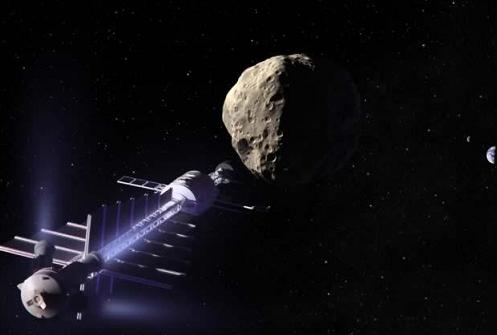NASA scientists have come up with an effective but surprisingly simple way to divert an asteroid that endangers the Earth from its orbit - parking a large spacecraft close to it, and gravity will do the rest
Yael Petar

NASA scientists have come up with an effective but surprisingly simple way to divert an asteroid that endangers the Earth from its orbit - parking a large spacecraft close to it, and gravity will do the rest.
Previous proposals focused on deflecting an approaching asteroid, using a nuclear explosion. But the experts at NASA believe that a "gravitational tractor" can realize the rescue operation by creating an invisible tow rope that will pull and divert the rock from its deadly path. "Most people envision the Hollywood stunts - throwing nuclear weapons at him," says Edward Lowe, a NASA scientist and astronaut who was one of the developers of the idea. But the explosion will create broken pieces, some of which may still damage the Kdvah. "This is the 'explode-and-hope' strategy," adds Lew.
"paint pots"
Another suggestion is to detonate a nuclear bomb near the asteroid. The radiation sheet that will be created should push the object out of its orbit, but there is the same risk that stray particles will fly towards the asteroid, in the event that the asteroid shatters. A weirder idea is to paint the face of the asteroid white. This should change the amount of solar energy it radiates, and change the direction of its trajectory. But the amount of paint needed for such an operation is huge.
Initially, Lowe and his colleagues thought of landing a rocket on the surface of the asteroid, with the goal of gently nudging it out of orbit. But the lack of gravity means the craft will have to stick itself in front of the asteroid, which could prove tricky, because the asteroid is more of a pile of gravel, Lowe explains.
And to add fuel to the fire, asteroids often rotate, so a push, not only may not divert it from its orbit, it may also increase its speed towards Earth.
Lowe's team came to the realization that the spacecraft did not need to land at all. Housing a heavy enough object near the asteroid for an extended period of time is able to create a gravitational pull strong enough to drag the object out of orbit. For an asteroid 200 meters wide, the space rocket has to weigh around 20 tons, stay 50 meters from the target for a whole year, in order to change its speed and throw it off course.
"This is, without a doubt, the best idea I've seen," says Eric Espaug, a planetary scientist from the University of California, Santa Cruz, "the idea will work, but you need a sufficiently large spaceship, and the right timing."
absorb the blow
Creating such a large spaceship is definitely feasible, says Lowe. In fact, the $XNUMX billion-plus Prometheus program, which was founded to explore space outside the solar system but was put on hold, planned to develop such a spacecraft, powered by nuclear fission.
The strategy depends crucially on the ability to anticipate the asteroid threat 20 years in advance. For large objects, the scheme is practical. But according to Espaug, many asteroids - smaller than 500 meters - may approach without us noticing them until they are a few years away from hitting the Earth.
Espaug claims that it would be more effective to invest in the aforementioned forecast regarding small asteroids that may hit the Earth, than to invest in the design of massive spacecraft. Governments will then be able to take care of evacuating the areas under threat. "In many cases, it would make more economic sense to let it collide," he says.
